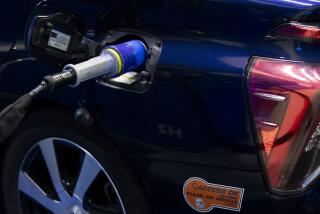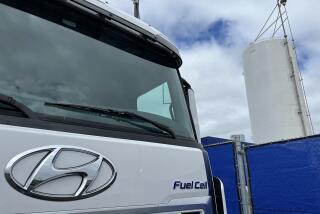H 2 Go
- Share via
DETROIT — As the search accelerates for better power sources for cars and trucks, a proven but problematic technology--the hydrogen fuel cell--is getting a fresh look as possibly the most promising replacement for the internal combustion engine in the early part of the 21st century.
But fuel cell vehicles still face significant hurdles, particularly in finding room to store the hydrogen in the car and in the massive job of developing a network for getting hydrogen to motorists--an infrastructure that could cost up to $150 billion to put in place.
Now Chrysler claims it has come up with a practical solution to these problems, one it says could move the timetable forward 10 years--as early as 2007--for the introduction of significant numbers of affordable fuel cell vehicles.
Chrysler will announce today at the North American International Auto Show here that it has developed a way to convert conventional gasoline into hydrogen on board the vehicle. The hydrogen is fed into a fuel cell, then combined with oxygen to produce electricity to run the vehicle.
“With this technology, we think fuel cell vehicles can be here within 10 to 15 years,” said Christopher Borroni-Bird, advanced technologies specialist for Chrysler.
Chrysler is not claiming any breakthrough in fuel cell technology, and other auto makers are also working on fuel cell vehicles--both Mercedes-Benz and Toyota introduced prototype vehicles this year. But Chrysler is the first to pursue one that produces hydrogen on board from existing fuel sources.
“This is a big step forward in transforming the kinds of cars we drive in the next century,” said Frank O’Donnell, deputy director of Fuel Cells 2000, a nonprofit organization that promotes the technology.
The race to develop alternative-fuel vehicles has vast international implications. Auto makers and governments in Germany, Japan and the United States are pouring hundreds of millions of dollars into research of electric and hybrid vehicles powered by fuel cells, flywheels, ultracapacitors and exotic fuels.
In the United States, the Clinton administration has tried to kick-start Big Three research and development efforts through the Partnership for a New Generation of Vehicles. The industry-government initiative is an effort to develop an affordable 80-mile-per-gallon family car by 2004.
Chrysler’s proposed fuel cell vehicle is a byproduct of the PNGV effort. The company says it will produce a working model in two years, a hybrid vehicle that also uses batteries for cold starts and quick acceleration.
The auto maker claims its six-passenger sedan will be quieter and more durable than a conventional gasoline-powered car while matching its performance. It will be 50% more fuel-efficient than today’s vehicles and have 90% lower emissions.
Environmentalists point out that other auto makers are developing fuel cell vehicles with no noxious emissions. They say Chrysler’s approach might get fuel cell vehicles to market faster, but it will continue our reliance on imported oil by pushing back development of an integrated hydrogen production, distribution and refueling system.
“It could be the right technology but the wrong fuel,” said Jason Mark, an energy analyst with the Union of Concerned Scientists. “It could be a stepping stone or a roadblock.”
However, Chrysler, whose research and development budget is much smaller than those of domestic rivals General Motors and Ford, says it is taking a marketing approach toward the development of alternative-fuel vehicles. It says it wants to engineer technology to meet the needs of customers, not manipulate consumer taste to meet a new technology.
The auto maker maintains it is more practical and economical to use the existing gasoline-based system of production and retailing rather than rely on development of a hydrogen-based one that would take decades and tens of billions of dollars to build.
“Basic economics tell us this infrastructure is not going to change overnight just because car companies have fuel cell prototypes that run on hydrogen,” said Francois Castaing, Chrysler vice president of vehicle engineering.
Fuel cells were invented in 1839 by Sir William Grove but remained largely a curiosity until NASA made extensive use of them in space missions. Both the Gemini and Apollo spacecraft used fuel cells.
They operate on a basic electrochemical reaction that scientists have long understood--essentially the reverse of electrolysis. In electrolysis, an electric current is run through water to break the liquid down into its basic components, hydrogen and oxygen. A fuel cell, using a platinum catalyst, combines hydrogen with oxygen to create electricity and water. In vehicles, the electricity is routed to small motors in the wheels.
For autos, the attraction of fuel cells is that they combine some of the advantages of conventional gas cars--long range and quick acceleration--with the quiet, low maintenance and clean emissions of electric vehicles.
The use and development of fuel cells for cars and trucks has been held back by their cost, size, performance and storage and infrastructure issues. But great strides have been made in some of these areas in recent years.
For instance, a decade ago a fuel cell cost 1,000 times more than a gasoline-powered engine. Today, it costs about $30,000, only 10 times that of a typical internal combustion engine.
“The cost is coming down dramatically and we suspect it will continue to come down,” said Peter Rosenfeld, Chrysler’s director of advanced technical planning.
The size of fuel cells has also been reduced greatly. In 1994, when Mercedes-Benz unveiled a fuel-cell-powered prototype minivan, the fuel cell occupied the entire cargo bay, leaving room for only a driver and a passenger. Last April, it showed an updated version of the same vehicle with the fuel cell packed under the van’s rear seats--and room for a driver and six passengers.
*
Already, fuel cells are beginning to show up in some large vehicles. Ballard Power Systems of Vancouver, Canada, is building three fuel cell buses that will be on the streets of Chicago in 1998. It is also supplying Mercedes-Benz with fuel cells.
Hydrogen, a gas when at normal temperatures, can be compressed and stored in heavy metal cylinders. They tend to be bulky, capable of carrying only enough of the gas to provide about half the range of traditional cars. Hydrogen can also be liquefied at low temperatures or stored in a solid state using expensive metal hydrides or alloys. Toyota is using a form of solid hydrogen in its prototype shown in October.
Safety is also a primary concern with hydrogen, which is volatile and highly flammable as a gas. But most experts consider hydrogen no more dangerous than gasoline or natural gas, and they say it can be safely stored on board vehicles.
An even bigger obstacle than storage is the almost total absence of a hydrogen production, distribution and refueling infrastructure that will be essential if such vehicles are to become practical for motorists.
“We’ve seen very little success in developing any alternative-fuel infrastructure,” Mark said.
To address this issue, a number of companies have been working to develop small processors, or so-called reformers, that turn more traditional fuels such as gasoline into hydrogen and other harmless gases on board the vehicle. Chrysler is using technology developed by the laboratory division of the Arthur D. Little Co. consulting company in Cambridge, Mass.
“Getting alternative fuels started is always the hardest part because of the lack of a fuel infrastructure,” said Jeffrey Bentley, director of technology and product development for Little. “We have tried to leapfrog the infrastructure issue by using gas right out of the pump.”
The processor consists of a number of units that break down the gasoline into hydrogen for the fuel cell. First, a vaporizer--6 inches in diameter and 20 inches long--converts the gasoline to a gaseous form.
Next the gas moves to a partial oxidizer, a 14-by-22-inch canister equipped with a sparkplug to initiate partial burning. The vaporized fuel is then combined with air to produce hydrogen and carbon monoxide.
The gases move into another unit where steam acts with a catalyst to turn the harmful carbon monoxide into carbon dioxide. Additional hydrogen is also produced from this process.
Finally, the fuel undergoes oxidation in which injected air reacts with a catalyst to remove any remaining carbon monoxide, leaving hydrogen-rich gases that are fed into the fuel cell.
*
Chrysler’s six-passenger sedan is likely to have a tailpipe for emission of carbon dioxide, nitrogen and water, most of which will be reused by the on-board processor.
Though the vehicle is not zero-emission, Chrysler hopes it might eventually qualify as an equivalent zero-emission vehicle, a new class of low-emission autos under consideration by the California Air Resources Board.
By bringing a practical fuel cell vehicle to the market quicker, Chrysler argues, the clean air benefits will be greater than if it were required to wait to make zero-emission vehicles that rely on a hydrogen infrastructure.
“This is not pie in the sky,” Rosenfeld said. “This is a potential alternative to the engine of today.”
(BEGIN TEXT OF INFOBOX / INFOGRAPHIC)
Fueling Change
Vehicles powered by hydrogen fuel cells--such as the Chrysler prototype being unveiled today at the North American International Auto Show--won’t be available to the public for at least 10 years. But the prototype features a system that could bring fuel cells much closer to reality. A look at how this technology can produce an almost pollution-free vehicle:
1. Gasoline travels from the tank in the rear of the vehicle to a 6-by-20-inch fuel vaporizer, where it is heated and converted into gases.
2. The gasoline vapors are combined with air in a 14-by-22-inch “partial oxidizer,” producing hydrogen and carbon monoxide.
3. This mixture then moves into a third unit where steam acts as a catalyst to turn the harmful carbon monoxide into carbon dioxide and additional hydrogen.
4. As the fuel travels to a fourth canister, the injected air reacts with a catalyst to remove any remaining carbon monoxide, leaving almost pure hydrogen.
5. The hydrogen gas is fed into an 8-inch-by-5-foot fuel cell, where an electrical charge is created to turn the rear wheel motors (See explanation at right).
6. Some of the water produced in the fuel cell flows back into a reservoir. A portion of this water is used in Step 3, while the remainder is vented into the atmosphere.
How the Fuel Cell Works
Hydrogen enters one side of the fuel cell, which is comprised of a series of stacked platinum plates (carbon electrodes), and binds to the platinum, which strips off electrons, causing a negative charge to build. The electrons are unable to pass through a membrane between the plates and instead are channeled to an electric motor, providing the current to drive the vehicle. The electrons are then returned to the positively charged side of the platinum plate, where they are combined with oxygen to form water.
Sources: Automotive News, Chrysler Corp., Union of Concerned Scientists
Researched by JENNIFER OLDHAM / Los Angeles Times






